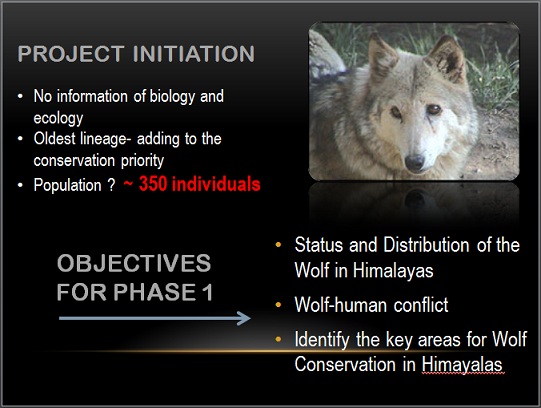Himalayan Wolf, one of the beautiful wolf species in the world, is considered one of the rare mammal too. Unfortunately, this gorgeous wolf found the Himalayan region has been studied on very few occasions. A proper study and research on the species is very important to save it from extinction. And the encouraging news is that Wildlife Institute of India has already initiated a project and it is already taking a roll.
Shivam Shrotriya, a researcher at Wildlife Institute of India, has completed the phase 1 of a project on “Ecology and conservation of Himalayan Wolf” under the guidance of Dr. Bilal Habib & Dr. Y.V. Jhala of the same institute. The project is also funded ‘The Mohamed bin Zayed Species Conservation Fund‘. The project focuses to fill the huge gap on the study on the biology and ecology of the Himalayan Wolves.
Till now whatever studies have been done on the Himalayan Wolves reveal that the Himalayan lineage of wolves, spread from Spiti to Sikkim, including Nepal are the most ancient lineages wolves of the world. Population estimation of wolves in Ladakh and Spiti by earlier studies revealed the presence of just around 350 individuals left in the wild.
The current research has taken various steps further on the Himalayan Wolf studies. The study concentrates on a baseline survey across the Himalayan and Trans-Himalayan landscapes to identify key areas for wolf conservation. Since October 2010, 90 villages and groups of nomadic herders have been visited and 244 interviews have been conducted using semi-structured questionnaires for obtaining records of wolf sighting by the local people and livestock predation, in the states of Jammu & Kashmir and Himachal Pradesh in India. Indices were developed to compare the level of wolf-human conflict and wolf presence across the Protected Areas.
The initial results of the study reveals that Wolves accounted for 11.2% cases of livestock predation as compared to leopard (30.8%) and snow leopard (17.5%) in Himachal Pradesh and 57% cases compared to leopard (17.6%) in Jammu & Kashmir. In Himachal Pradesh, Conflict index was found to be higher in Kibber
Wildlife Sanctuary (9.12) followed by Pin Valley National Park (1.56). In Jammu & Kashmir, the Conflict index was higher in Thajwas-Baltal Wildlife Sanctuary (13.89) followed by Hirpora Wildlife Sanctuary (9.43) and Changthang Cold Desert Sanctuary (4.08). Wolf Presence index
was higher in Kibber (0.76) followed by Pin Valley (0.34) and Hirpora (1.00) followed by Changthang (0.88) and Thajwas-Baltal (0.80). Considering if the livestock predation cases and the sightings by the people are relative to the abundance of wolves, Kibber and Thajwas-Baltal with adjoining Overa-Aru Wildlife Sanctuaries and Changthang Cold Desert Sanctuary are seen as potential sites of higher abundance.
These are pioneer data on the Himalayan Wolves behaviour and habitat. The project aims to go further deep in the research. We keep great hope for the success of this project which in turn will save one the magnificent species to vanish away from our sight.
Relivearth has identified Himalayan Wolf as one of the species that needs support and attention from public. Please view older articles on the species and support the cause of this research effort by commenting and providing ideas.
Tracing the lineages of Himalayan Wolves
Himalayan Wolf:Conservation Thought
Time to Act for Himalayan Wolf



Recent Comments